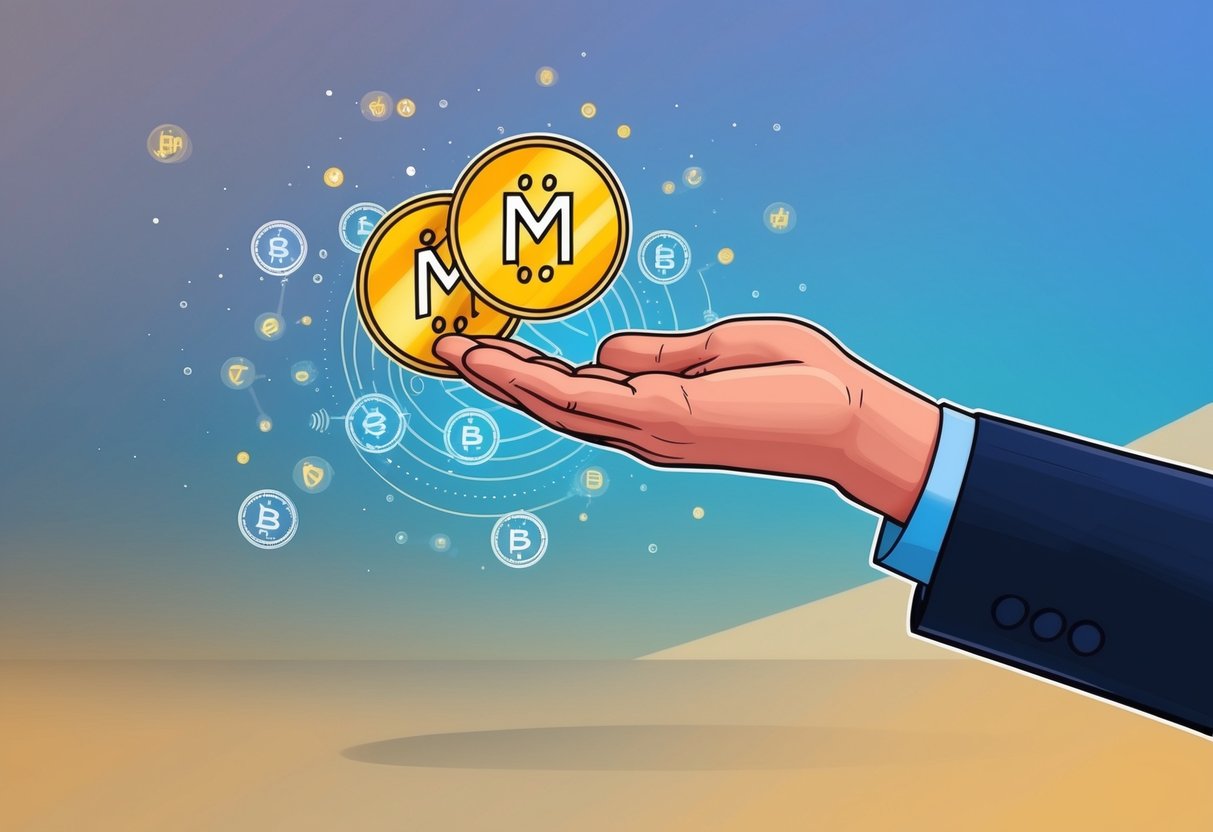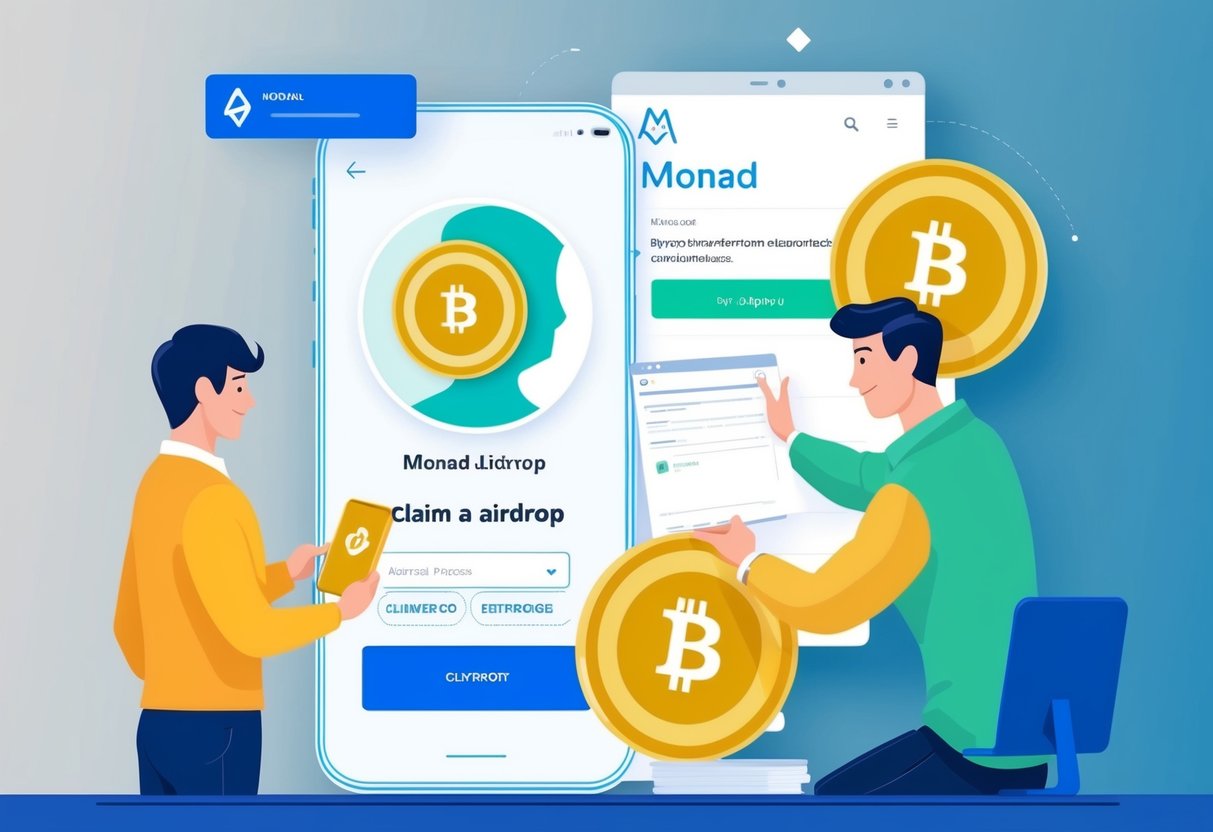
The Monad airdrop claim gives users a chance to earn free tokens by completing simple tasks in the Monad ecosystem. With growing interest in blockchain projects, many people are looking for step-by-step guides to make sure they don’t miss out on these opportunities.

Anyone can try to participate in the potential Monad airdrop by setting up a wallet, claiming test tokens, and interacting with Monad’s activities. These easy steps can help users become eligible for a future reward if the airdrop goes live.
Many crypto communities are sharing updates, so checking official sources and following instructions can help maximize the chances of qualifying for the Monad airdrop. This article breaks down the tasks and shares what users should know to take part.
Today’s Airdrop Checker Even: Step-by-Step Claim:
🌐 Step 1: Visit the Official Airdrop Reward Page.
Dive into the action by heading to the official airdrop page, where all live events are waiting for you. Log into your account by connecting your wallet from any MOBILE DEVICE.
📱 Step 2: Use Your Mobile Wallet
Eligibility checks are mobile-exclusive! Grab your smartphone and ensure you’re using a mobile wallet to participate.
💎 Step 3: Meet The Eligibility Criteria
Make sure your wallet isn’t empty or brand new—only active wallets qualify. If one doesn’t work, don’t worry! Try again with another wallet to secure your rewards. You can claim many rewards from multiple wallets, so try to use multiple wallets to increase your chance to claim.
💰 Step 4: Withdraw The Tokens
After signing the approval from your wallet, wait 5 to 10 minutes, and then congratulations! You will see a token claim in your wallet. You can easily exchange your tokens from SushiSwap, PancakeSwap, and many more.
Understanding Monad and Its Ecosystem

Monad is a high-performance Layer 1 blockchain focused on speed, security, and efficiency. Its ecosystem brings a range of decentralized applications, including DeFi and NFTs, that benefit from improved transaction processing and low costs.
What Is Monad?
Monad is a next-generation blockchain that operates as an independent Layer 1 network. It was built to handle the rising demands of the blockchain sector by increasing transaction throughput and decreasing latency.
It uses parallel execution to process multiple transactions at the same time. This means faster transaction speeds and higher scalability compared to many older blockchains.
Unlike some Layer 2 solutions that rely on existing blockchains, Monad offers its own infrastructure. This approach allows developers to build decentralized applications directly on its platform, unlocking new possibilities in DeFi, NFTs, and beyond.
Key Features of Monad
- High Performance: Monad handles up to 10,000 transactions per second with 1-second block times. This makes it suitable for high-demand environments.
- Parallel Execution: The platform processes multiple transactions at once, improving efficiency and reducing wait times.
- Scalability: As more users and decentralized applications join the ecosystem, Monad can maintain performance without slowing down.
Security is also central. Monad uses advanced protocols to protect transactions and assets. Lower hardware requirements make it accessible for a broader range of users and developers.
These features together support a more reliable and user-friendly experience for people and businesses using blockchain technology.
Monad Ecosystem Overview
The Monad ecosystem includes a wide variety of decentralized applications (dApps) such as lending platforms, decentralized exchanges, and NFT marketplaces. Because the blockchain is efficient, these dApps can offer lower fees and fast interactions.
DeFi within Monad benefits from high transaction speed and scalability, making financial applications more practical and affordable. NFTs on Monad can be created, bought, and sold quickly without high costs.
Ecosystem support includes resources for developers to build, test, and launch dApps easily. As the network grows, more projects are joining, helping to expand the usefulness and adoption of Monad across the blockchain sector.
Monad Airdrop Claim Process

Claiming the Monad token airdrop involves preparing a compatible wallet, following specific steps, and staying updated with official information. Knowing who is eligible, how to claim, and being aware of possible issues can make the process smoother and help users avoid common pitfalls.
Eligibility Criteria
To qualify for the Monad airdrop, users usually need to complete certain actions on the Monad testnet. This may include setting up a wallet compatible with EVM addresses, such as MetaMask.
Participation often requires users to engage in missions or tasks. These may cover sending testnet transactions, interacting with new projects in the Monad ecosystem, or providing feedback through official forms or feedback portals. Some testnet activities might involve using a Monad faucet to get free MON test tokens needed for participation.
Sometimes, holding specific NFTs or joining Fantasy Top events, early access trials, or the Monad Telegram group can give users a better chance of qualifying. Official updates about the latest airdrops or early access programs are usually shared on the Monad Telegram channel or via their website.
How to Claim Monad Airdrop
Claiming the Monad airdrop starts with having a supported EVM wallet set up. MetaMask and other similar wallets are commonly used.
Users must make sure their wallet address is registered through testnet activities. This includes obtaining MON tokens from the Monad faucet and using them to complete missions or interact with smart contracts on the Monad layer-1 blockchain.
Once the mainnet launches and the claim process opens, eligible users navigate to the official Monad airdrop website. Here, they connect their wallet, check eligibility, and claim tokens. They may be asked to complete some final steps, such as verifying transactions or confirming their wallet address.
Important Dates and Updates
The Monad mainnet launch date will determine when claims begin. There may be a public announcement or countdown on the Monad official website and Telegram channel.
To avoid missing out, users should join the Monad Telegram group or channel, where official updates and notifications are shared. Claim periods usually have a fixed window. For example, it might last two weeks, starting the day after the mainnet goes live.
Updates on changes to eligibility, extra missions, or feedback opportunities can also be announced before the claim. Participants should watch for fake websites or scam channels during this period and only trust official sources.
Common Challenges during Claiming
Some users face problems during the claim process. A frequent issue is using an unsupported wallet or an incorrect EVM address. Ensuring the wallet matches the one used on the testnet helps avoid this mistake.
Technical glitches, high transaction fees, or network congestion can slow down claims, especially right after the mainnet launch. This can result in failed or delayed transactions. Sometimes, the faucet may not work, making it hard to get MON test tokens for required testnet activities.
Lost access to Telegram announcements or missing feedback deadlines may affect eligibility or cause confusion. Users should double-check they followed all steps and use only official links to avoid scams. If a problem occurs, reaching out through the official Monad Telegram group can provide quick help.
Integrating with Monad: For Users and Developers

Monad supports Ethereum Virtual Machine (EVM) compatibility, making it easier for users and developers to interact with its network. Testnet access allows for safe experimentation, while deployment tools streamline the process of building decentralized applications (dApps) and smart contracts.
EVM Compatibility and Migration
Monad is fully EVM-compatible. This means that developers who have built on Ethereum or other EVM blockchains can migrate their smart contracts to Monad with only minor adjustments.
A key benefit is that smart contracts written in Solidity or Vyper, the major Ethereum languages, will work on Monad. This reduces the learning curve and infrastructure changes needed. Existing tools like MetaMask, Remix, and Hardhat remain usable with Monad, making the switch familiar for most users and teams.
Migration also means that decentralized applications (dApps) originally deployed on Ethereum can be moved to Monad. This brings efficiency benefits and often lower transaction fees. Using a similar setup as Ethereum helps developers quickly test and adapt their projects.
Testing on Monad Testnet
The Monad testnet offers a risk-free environment for users and developers to try new features. To get started, users must set up a compatible wallet and connect to the Monad testnet network.
Testnet MON tokens are available through a faucet, which gives users access to tokens needed for testing. These tokens have no real-world value but allow transactions and contract deployment on testnet. Testing includes sending transactions, deploying contracts, and interacting with sample dApps.
Developers use the testnet to detect bugs and ensure functionality before launching on mainnet. The testnet mimics the main Monad network, giving realistic results. This process helps maintain security and performance for users and projects.
Developing dApps and Deploying Smart Contracts
Monad’s infrastructure supports developers building and launching dApps and smart contracts. Its EVM compatibility ensures that many existing Ethereum development tools can be used, including Remix IDE, Truffle, and Hardhat. Developers write contracts in common languages like Solidity.
Steps to develop and deploy on Monad include:
- Writing the smart contract code
- Testing the contract locally and on the Monad testnet
- Using deployment tools to launch on the live Monad network
Monad’s design allows developers to focus on functionality, not network limitations. Compared to platforms like Ethereum or Solana, Monad offers high throughput and lower fees, making it appealing for new dApps. Documentation and community support further assist developers throughout the process.
Future of Monad and the Broader Blockchain Landscape
Monad aims to improve how blockchains handle transactions, with a focus on speed, scalability, and attracting new users. Its funding, technology, and growing ecosystem may help it shape the blockchain sector in practical ways.
Potential Impact of Monad on the Industry
Monad’s mainnet launch brings a new approach called parallel execution, which lets many transactions happen at once. This design can boost transaction speeds and make blockchains more scalable, addressing a major weakness in older blockchains like Bitcoin and Ethereum.
These improvements help developers build complex apps such as decentralized finance (DeFi) services and NFT platforms. Fast and reliable networks draw users who want low fees and quick settlements.
If Monad’s technology works as planned, other blockchains may try similar solutions. This can set new standards for performance and user experience in the industry.
Funding, Backers, and Ecosystem Growth
Monad’s growth has strong backing from major investors. It raised millions in a seed round led by Paradigm, a well-known name in crypto investing. Funding gives Monad the resources to build its network, attract developers, and boost its ecosystem.
Financial support also means Monad can offer incentives, like testnet tokens and airdrops, to early users and builders. Developers can experiment with native tokens and on-chain applications in the testnet environment.
The Monad ecosystem is growing, with projects ranging from wallets to DeFi apps. Ecosystem partners and backers often join the official Telegram group or Telegram channel to stay updated and collaborate.
Community and Exchange Listings
A strong community is key for the success of any blockchain. Monad is building its user base through airdrops and community engagement. The Telegram group and channel serve as main hubs for news, support, and feedback from users.
Token liquidity and trading access are important. Monad is reportedly in talks with several cryptocurrency exchanges for future listings. Partners such as Stone and Magic Eden could also help widen access to Monad native tokens.
When native tokens become available on exchanges, it will likely increase visibility and attract more holders. This can help grow both the community and the practical uses of Monad across the blockchain sector.
Frequently Asked Questions
Monad airdrop participants often ask about how to join, which wallets to use, and what makes someone eligible. Other common questions focus on where to find the claim link, the use of testnet faucets, airdrop risks, and key eligibility dates.
How can I participate in the Monad airdrop?
To participate, users need to interact with the Monad ecosystem. This often means setting up a supported wallet, using Monad apps, or joining testnet activities. Completing tasks or transactions on Monad projects may also help.
What are the requirements to be eligible for the Monad airdrop?
Eligibility for the Monad airdrop usually depends on taking certain actions such as using the Monad network, holding specific assets, or performing tasks. Sometimes, early participation or engagement on testnet platforms is required. Following official updates is important because requirements can change.
Where can I find the official link to claim the Monad airdrop?
The official claim link for the Monad airdrop should be available on the Monad project’s website or official social channels. Avoid unofficial links to reduce the risk of scams or phishing. Always double-check URLs before submitting wallet or personal information.
What is the Monad airdrop listing date of eligibility?
The Monad airdrop eligibility date is usually announced by the Monad team through updates or snapshots. This date is when the project reviews activity or wallet holdings to decide who can claim tokens. Users should check for the latest announcements to ensure their activity is included.
Can I use a faucet to claim tokens on the Monad testnet?
Yes, users can often use a testnet faucet to get MON tokens and interact with Monad’s testnet. These tokens are for testing and participation in trial activities. They cannot be traded or redeemed for mainnet tokens.
Are there any risks associated with farming for the Monad airdrop?
Farming for airdrops can come with risks. Common concerns include phishing sites, smart contract vulnerabilities, and high transaction fees. Users should be cautious of unofficial platforms and always use trusted wallets and verified links.
Leave a Reply